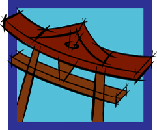
 |
|
Hachiko: Japan’s Favorite “Dog in Waiting”by Tim YoungFrom SATELLITE 55, Fall 1999Tim Young, Editor
The year was 1925. Every morning, Professor Eizaburo Ueno walked to Shibuya Station, accompanied by his loyal dog, Hachi, nicknamed Hachi-ko. Hachiko didn’t accompany his master to his teaching job at the Imperial University (now known as Tokyo University), but when Professor Ueno returned every day at 3 p.m., the dog was always at the station waiting for him. However, on May 21 of that year, Ueno died of a stroke while at the university. Hachiko went to Shibuya as always to meet his master, but 3:00 came and went, and the professor didn’t arrive. So Hachiko waited. And waited. The akita must have known something was wrong, but nonetheless he returned to the station every day at 3:00 to meet the train. Soon people began to notice the loyal dog’s trips made in vain to meet his master. Ueno’s former gardner, the Shibuya Stationmaster, and others began feeding Hachiko and giving him shelter. Word of Hachiko’s unaltered routine spread across the nation, and he was held up as a shining example of loyalty. People traveled to Shibuya simply to see Hachiko, feed him, and gently touch his head for luck. The months turned to years, and still Hachiko returned to Shibuya Station daily at 3 p.m., even as arthritis and aging took their toll. Finally, on March 7, 1935 — nearly ten years after last seeing Professor Ueno — the 12-year-old akita was found dead on the same spot outside the station where he had spent so many hours waiting for his master. Hachiko’s death made the front pages of major Japanese newspapers. A day of mourning was declared. Contributions poured in from all over the country to memorialize the dog that had won the hearts of the nation. Sculptor Takeshi Ando was hired, with the money that had been contributed, to create a bronze statue of Hachiko. It was placed on the exact spot where Hachiko had waited for so long. Within a few years, however, Japan was at war, and any available metal was melted down to make weapons. Not even Hachiko’s statue was spared. However, after the war, in 1948, Ando’s son Teru sculpted a new Hachiko—the statue that stands outside Shibuya Station to this day. This is not the only monument to Chuken (“loyal dog”) Hachiko to be found in Tokyo, however. Aoyama Cemetery, two kilometers west of TAC, contains a memorial to Hachiko on the site of Professor Ueno’s grave. Some of Hachiko’s bones are reportedly buried there, but in fact, Hachiko can still be seen, in the fur—stuffed, in the National Science Museum, northwest of Ueno Station. Back in Shibuya, Hachiko’s statue sits in a noble pose, forever waiting for his master. And, appropriately, his statue, the best-known landmark and meeting place in Shibuya, is where hundreds of people every day sit and wait for their friends.
|
Copyright 2003  This page last updated
March 4, 2003
. E-mail Tim
This page last updated
March 4, 2003
. E-mail Tim